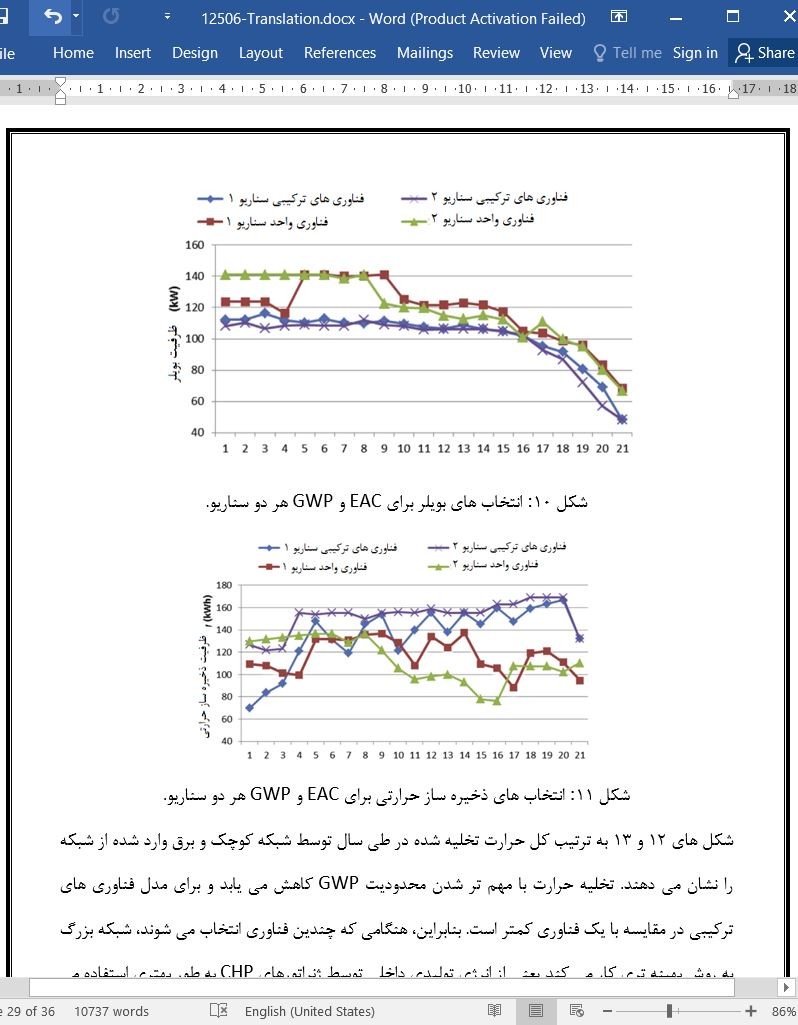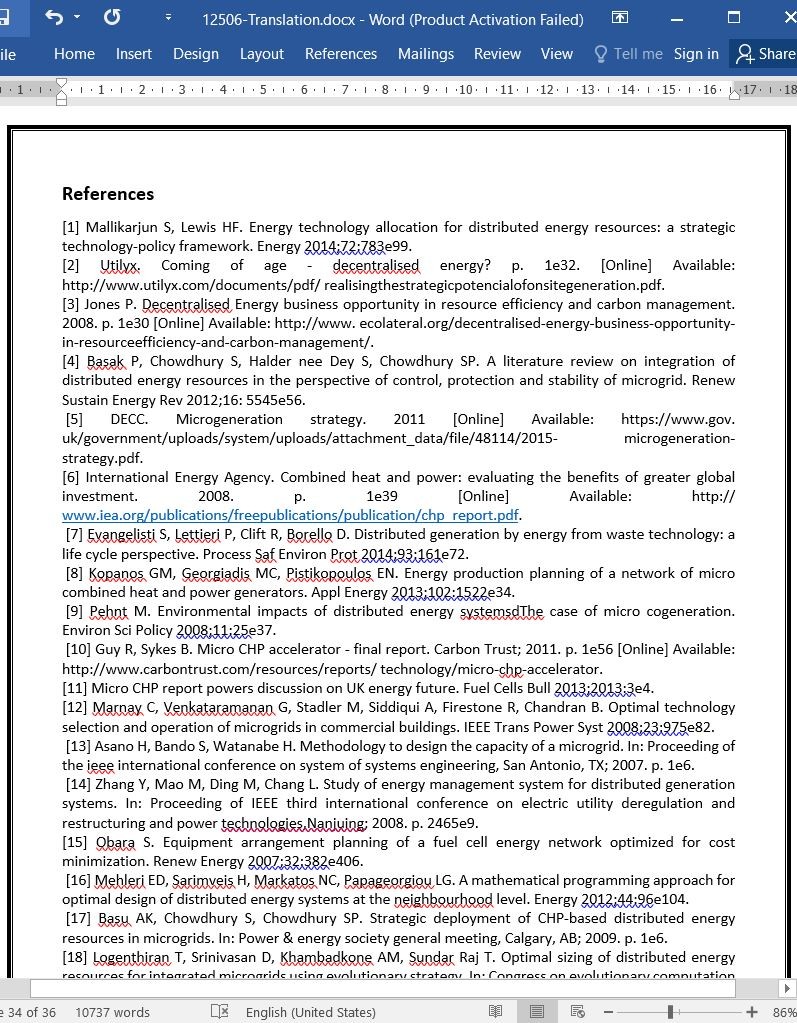
دانلود مقاله طراحی بهینه شبکه های کوچک مبتنی بر CHP
چکیده
به عنوان جایگزینی برای سیستم های فعلی تولید انرژی، شبکه های کوچک برای ارائه انرژی محلی با هزینه های کمتر انرژی و انتشار گاز با به کارگیری منابع توزیع شده انرژی (DER) پذیرفته می شوند. اخیراً چندین فناوری مرکب از حرارت و توان برای به کار گیری در مقیاس داخلی توسعه داده شده اند. طراحی بهینه DERها در شبکه های کوچک مبتنی بر CHP نقش مهمی در ترویج نفوذ سیستم های شبکه کوچک ایفا می کنند. طراحی بهینه شبکه های کوچک در واحد های CHP در این کار با ادغام پایداری زیست محیطی و اقتصادی در یک مدل بهینه سازی چند منظور مورد بررسی قرار می گیرد به طوری که نتایج حاصل از ارزیابی طول عمر شبکه های کوچم بررسی شده را ادغام می کند. این نتایج نشان می دهد که به کارگیری چندین فناوری CHP دارای هزینه کمتر همراه با صرفه جویی زیست محیطی در مقایسه با موردی است که تنها یک فناوری در هر سایت راه اندازی می شود که شبکه های کوچک به روش بسیار موثرتری کار می کند هنگامی که چندین فناوری به کار گرفته می شوند. به طور کلی، سلول های سوختی غضای تبادل پروتون (PEM) به عنوان فناوری پایه CHP برای بیشتر راهکارها انتخاب می شوند که تاثیرات زیست محیطی کمتری با هزینه کم را ارائه می کند. با این حال، موتورهای احتراق داخلی (ICE) و موتورهای استریلینگ (SE) ترجیح داده می شوند اگر تقاضای دما زیاد باشد.
1. مقدمه
به عنوان جایگزینی برای تولید متمرکز انرژی، شبکه های کوچک برای ارائه انرژی به صورت محلی با به کارگیری منابع توزیع شده انرژی (DER) قابل پذیرش هستند. منابع DER شامل سیستم های متعددی همانند تولید انرژی، ذخیره سازی انرژی و مدیریت بار هستند. واحدهای موجود تولید انژی در نزدیکی کاربر انتهایی واقع می شوند [1]. آن ها می توانند به صورت موازی با شبکه الکتریکی استاندارد یا واحدهای مستقل باشند. این واحدها می توانند در یک سیستم شبکه کوچک به یکدیگر متصل شوند تا به محلات کوچکی خدمت رسانی کنند که به طور مستقل از طوی شبکه الکتریکی استاندارد تغذیه می شوند. گاز طبیعی در حال حاضر سوخت اصلی برای DER است اما منابع انرژی تجدید پذیر به آسانی قابل ادغام هستند و مزیت های زیست محیطی مهمی را در صنعت تولید برق فراهم می کنند. یکی از کاربردهای اصلی DER تولید ترکیبی توان و حرارت (CHP) است که کارآمدی سیستم تولید برق با استفاده از حرارت اتلافی برای تولید انرژی حرارتی را افزایش می دهد. یک نمونه شبکه کوچک در شکل 1 نشان داده شده است. سیستم های DER با سرعت زیادی در بریتانیا در حال رشد هستند. انرژی توزیع شده حدود 9 درصد کل ظرفیت تولید در سال 2011 را به خود اختصاص داده است؛ Verdantix که یک شرکت تحلیلگر انرژی است، پیش بینی کرده است که کل ظرفیت راه اندازی فناوری های انرژی توزیعی تا سال 2030 به 17 گیگا وات خواهد رسید که 14 درصد ظرفیت تولید انگلستان تا سال 2030 را نشان می دهد [2].
7. نتیجه گیری ها
طراحی بهینه شبکه های کوچک با استفاده از ژنراتورهای CHP با توسعه یک مدل MILP همراه با چندین هدف با استفاده از روش محدودیت- ε مورد بررسی قرار گرفته است. این مدل ملاحظات زیست محیطی و اقتصادی را در نظر گرفته است. روش LCA برای ارزیابی تاثیرات زیست محیطی طرح های مختلف شبکه کوچک به کار گرفته شده است که بعداً براساس معیارهای اقتصادی بهینه شده اند.
مدل پیشنهادی بر روی یک مطالعه مورد همراه با 5 مشارکت کننده از انواع مختلف ساختمان ها پیاده سازی می شود. این سناریوها همراه با دو مدل مختلف در نظر گرفته می شوند. نتایج حاصل از این مقاله نشان می دهد که یک شبکه کوچک با چندین فناوری CHP راهکار کم هزینه و زیست محیطی بیشتری را برای گروهی از کاربران مختلف نشان می دهد. تصمیم گیرندگان می توانند طرح شبکه کوچک مبتنی بر CHP خود را براساس راهکارهای بهینه به دست آمده Pareto انتخاب کنند.
Abstract
As an alternative to current centralised energy generation systems, microgrids are adopted to provide local energy with lower energy expenses and gas emissions by utilising distributed energy resources (DER). Several micro combined heat and power technologies have been developed recently for applications at domestic scale. The optimal design of DERs within CHP-based microgrids plays an important role in promoting the penetration of microgrid systems. In this work, the optimal design of microgrids with CHP units is addressed by coupling environmental and economic sustainability in a multi-objective optimisation model which integrates the results of a life cycle assessment of the microgrids investigated. The results show that the installation of multiple CHP technologies has a lower cost with higher environmental saving compared with the case when only a single technology is installed in each site, meaning that the microgrid works in a more efficient way when multiple technologies are selected. In general, proton exchange membrane (PEM) fuel cells are chosen as the basic CHP technology for most solutions, which offers lower environmental impacts at low cost. However, internal combustions engines (ICE) and Stirling engines (SE) are preferred if the heat demand is high.
1. Introduction
As an alternative to current centralised energy generation, microgrids can be adopted to provide energy locally by utilising distributed energy resources (DER). The DERs comprise several systems, such as energy generation, energy storage and load management options. The involved energy generation units are located near the end user [1]. They can be parallel to the standard electric grid or stand-alone units. Single units can be connected together in a microgrid system to serve small districts which can be powered independently from the standard electric grid. Natural gas is at present the primary fuel for DER, but renewable energy resources can be easily integrated allowing important environmental benefits in the power generation industry. One of the main applications of DER is the combined heat and power (CHP) generation, which increases the efficiency of the on-site power generation system using the waste heat for thermal energy production. A microgrid example is presented in Fig. 1. DER systems are growing fast in the UK. Distributed energy took about 9% of the total generation capacity in 2011; Verdantix, an independent energy analyst company, has forecasted that the total installed capacity of distributed energy technologies will increase to 17 GW by 2030, representing 14% of the expected UK generation capacity in 2030 [2].
7. Concluding remarks
The optimal design of microgrids with CHP generators has been addressed, through the development of an MILP model with multiobjective, using ε-constraint method. The model has considered both environmental and economic concerns. LCA methodology has been used to evaluate the environmental impacts of different microgrid designs which are then optimised based on economic metrics.
The proposed model is implemented on a case study with five participants of different building types. Three scenarios are considered with two different models. The results of this paper show that a microgrid with multiple CHP technologies represents a less expensive and more environmentally friendly solution for a group of different users. The decision makers can select their preferred CHP-based microgrid design from the obtained Paretooptimal solutions.
چکیده
1. مقدمه
1-1 طراحی بهینه و برنامه ریزی شبکه های کوچک
1-2 ارزیابی تاثیر زیست محیطی
1-3 هدف این مطالعه
2. ارزیابی چرخه زندگی شبکه های کوچک
2-1 فهرست چرخه طول عمر
2-2 ارزیابی تاثیر چرخه طول عمر
3. توصیف مساله
4. مدل بهینه سازی
4-1 محدودیت ظرفیت
4-2 شرط محدودیت شیب
4-3 محدودیت تقاضای انرژی
4-4 محدودیت های CHP
4-5 محدودیت های ذخیره سازی حرارتی
4-6 توابع هدف
4-7 روش محدودیت-ε با دو هدف
5. مطالعه موردی
5-1مشخصات فنی و هزینه های ژنراتورهای CHP شبکه کوچک
6. نتایج محاسباتی
6-1 سناریو اصلی
6-2 سناریو 1 و سناریو 2: مقایسه بین فناوری های واحد و ترکیبی
6-3 هزینه در مقابل GWP و AP
7. نتیجه گیری ها
منابع
Abstract
1. Introduction
1.1. Optimal design and planning of microgrids
1.2. Environmental impact assessment
1.3. Objective of this study
2. Life cycle assessment of microgrids
2.1. Life cycle inventory
2.2. Life cycle impact assessment
3. Problem description
4. Optimisation model
4.1. Capacity constraint
4.2. Ramp limit constraint
4.3. Energy demand constraint
4.4. CHP constraints
4.5. Thermal storage constraints
4.6. Objective functions
4.7. The ε-constraint method with two objectives
5. Case study
5.1. Technical characteristics and costs of the microgrid CHP generators
6. Computational results
6.1. Basic scenario
6.2. Scenario 1 and scenario 2: comparison between single and combined technologies
6.3. Cost vs. GWP and AP
7. Concluding remarks
References
- ترجمه فارسی مقاله با فرمت ورد (word) با قابلیت ویرایش، بدون آرم سایت ای ترجمه
- ترجمه فارسی مقاله با فرمت pdf، بدون آرم سایت ای ترجمه



